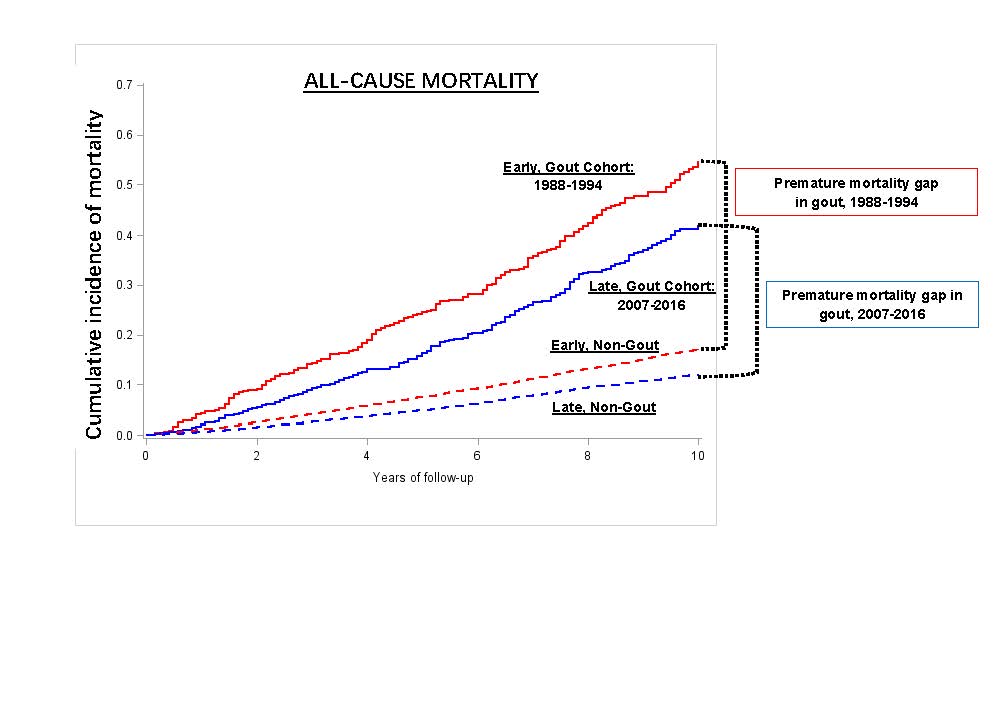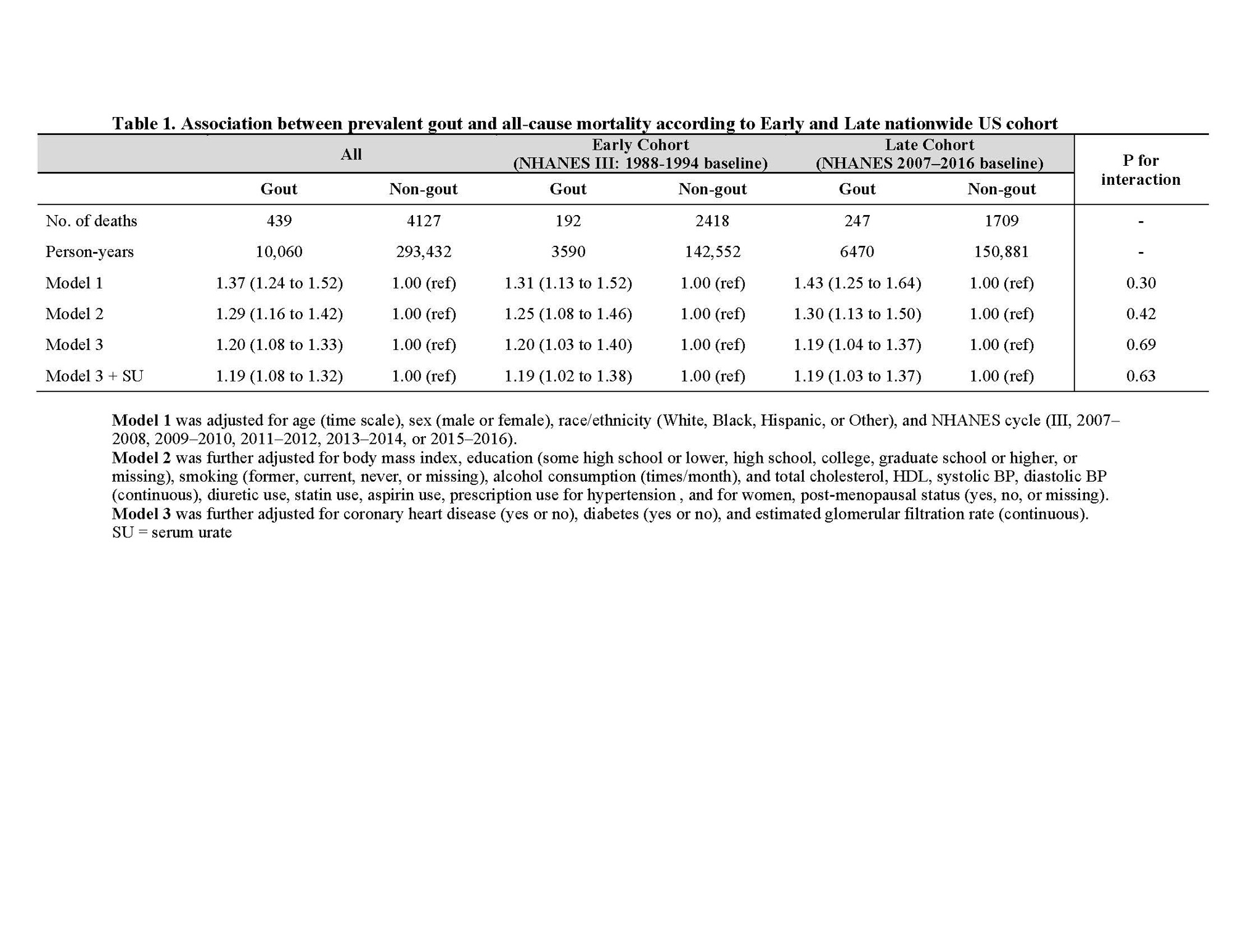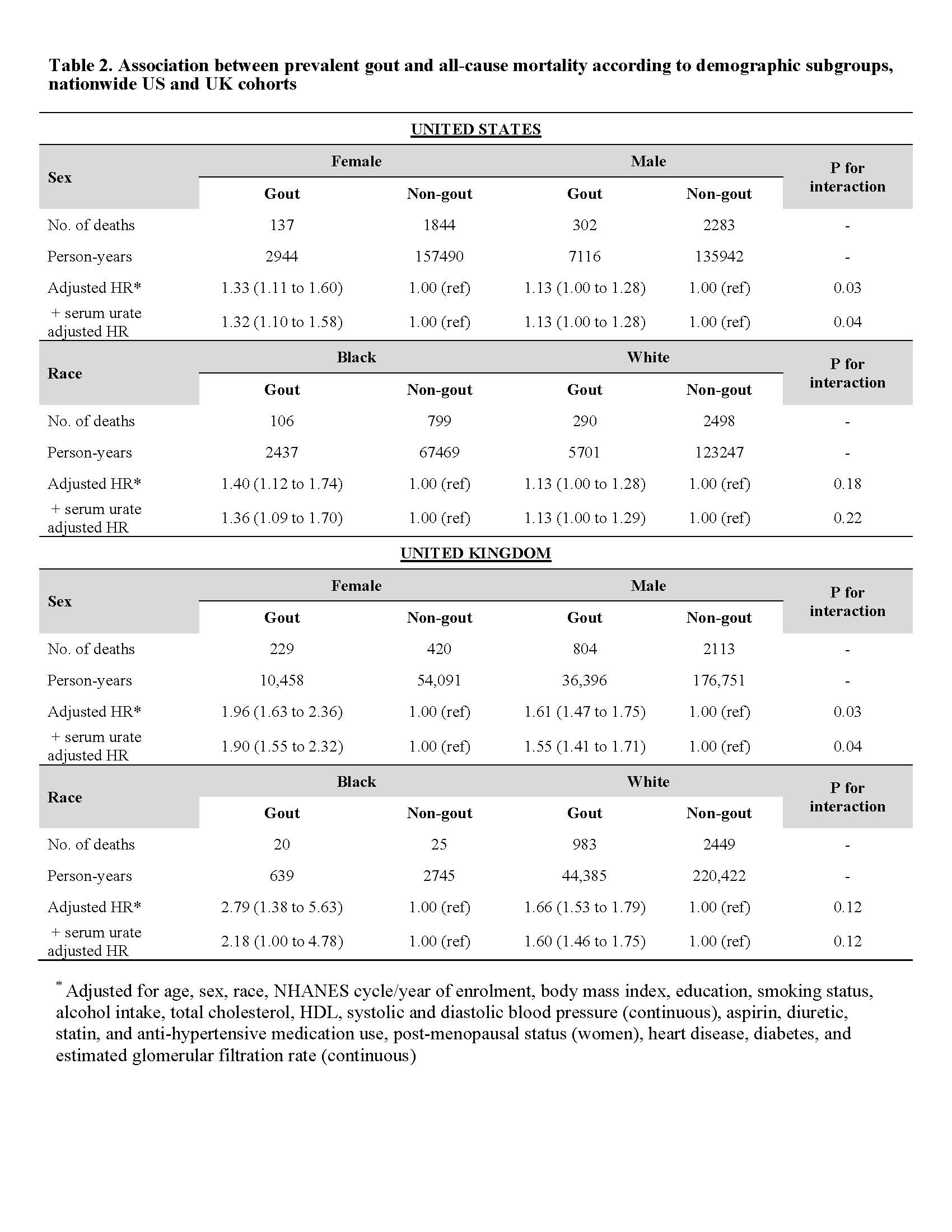Session Information
Date: Tuesday, November 14, 2023
Title: Plenary III
Session Type: Plenary Session
Session Time: 11:00AM-12:30PM
Background/Purpose: A recent UK study reported a transient increased cardiovascular risk after gout flare episodes [Cipolletta et al. JAMA 2022], which may translate to premature mortality for gout patients over the long term. Prior studies reported premature mortality in gout; however, it is unknown whether this mortality gap has improved over recent years at a national level.We prospectively evaluated the association between gout and the risk of all-cause and cardiovascular (CVD) mortality fully adjusting for serum urate (SU) and atherosclerotic cardiovascular disease (ASCVD) risk factors in the latest US general population data (as well as the UK).
Methods: Using nationally representative samples of US adults in the National Health and Nutrition Examination Survey (NHANES), linked prospectively with vital statistics data, we examined the independent association of prevalent gout with mortality risk and compared Early (NHANES III: 1988-1994 baseline) and Late cohorts (2007-2016 baseline), as well as key demographic subgroups defined by sex and self-reported race/ethnicity (Black vs. White).Hazard ratios (HRs) were calculated over 10 years adjusting for SU, ASCVD risk factors, cardiometabolic comorbidities, kidney function, and relevant medications. We replicated the Late cohort findings among incident gout in a nationwide UK cohort (2006-2010 baseline).
Results: US adults with gout had higher 10-year all-cause mortality rates than those without gout, in both the Early and Late cohorts, with similar magnitudes of excess mortality (Figure) and adjusted hazard ratios (HR) between the two cohorts (HR, 1.20; 1.03–1.40 and 1.19; 1.04–1.37, respectively; p for gout*time interaction=0.69).HRs changed minimally with further adjustment for SU (HR, 1.19; 1.02–1.38 and 1.19; 1.03–1.37, respectively) (Table 1).Late cohort findings were replicated among incident gout in the UK (adjusted HR, 1.61; 1.47–1.75).In both countries, associations were larger among women than men (HR 1.32 (1.10 to 1.58) in US and 1.90 (1.55 to 2.32) in UK; p for interaction=0.04) and prominent among Black individuals (Table 2).
Adjusted HR for cardiovascular mortality in the late US cohort was 1.39 (1.09–1.78); those for circulatory, cardiovascular, and coronary heart disease deaths among Britons with incident gout were 1.48 (1.24–1.76), 1.49 (1.20–1.85) and 1.59 (1.26–1.99), respectively.
Conclusion: Premature mortality in gout (beyond SU and ASCVD risk factors) has not improved over time in the US at a national level, despite improved survival in the general population, and is worse among women and possibly among Black individuals, among whom gout is already more prevalent compared to White individuals [PMID 35969396].Mortality gap was replicated among incident gout patients in the UK. This unclosing premature mortality gap suggests shortcomings in current gout care, particularly among women and possibly among Black patients and a potential role for targeted anti-inflammatory therapies such as daily colchicine for dual purposes of gout and CVD prevention, as is promoted in CVD prevention in European and Canadian cardiology guidelines.
Solid red line=Gout, Early Cohort (1988_1994), Dashed red line=Non-Gout, Early Cohort (1988_1994), Solid blue line=Gout, Late Cohort (2007_2016), Dashed blue line=Non-Gout, Late Cohort (2007_2016). The premature mortality gap in gout (difference between the solid and dashed lines) did not improve between the Early and Late cohorts.
* Adjusted for age, sex, race, NHANES cycle/year of enrolment, body mass index, education, smoking status, alcohol intake, total cholesterol, HDL, systolic and diastolic blood pressure (continuous), aspirin, diuretic, statin, and anti-hypertensive medication use, post-menopausal status (women), heart disease, diabetes, and estimated glomerular filtration rate (continuous)
To cite this abstract in AMA style:
McCormick N, Lin K, Yokose C, Lu N, Zhang Y, Choi H. Unclosing Premature Mortality Gap Among Gout Patients in the US General Population, Independent of Serum Urate and Atherosclerotic Cardiovascular Risk Factors [abstract]. Arthritis Rheumatol. 2023; 75 (suppl 9). https://acrabstracts.org/abstract/unclosing-premature-mortality-gap-among-gout-patients-in-the-us-general-population-independent-of-serum-urate-and-atherosclerotic-cardiovascular-risk-factors/. Accessed .« Back to ACR Convergence 2023
ACR Meeting Abstracts - https://acrabstracts.org/abstract/unclosing-premature-mortality-gap-among-gout-patients-in-the-us-general-population-independent-of-serum-urate-and-atherosclerotic-cardiovascular-risk-factors/



